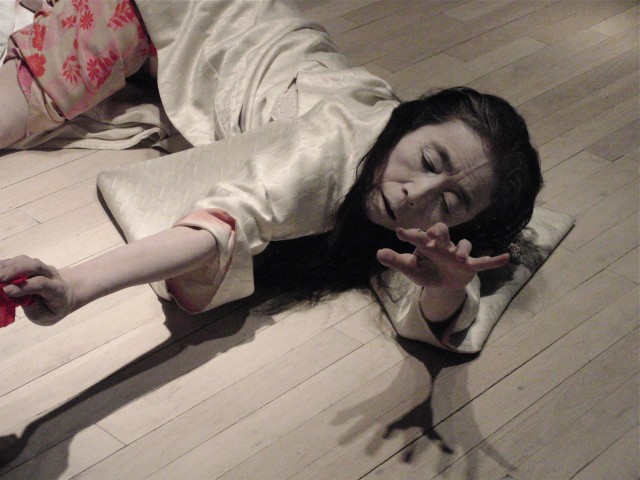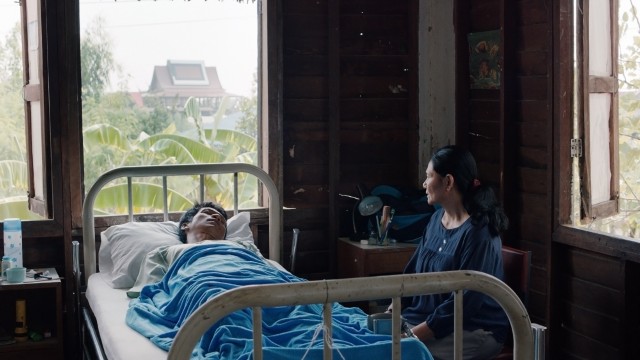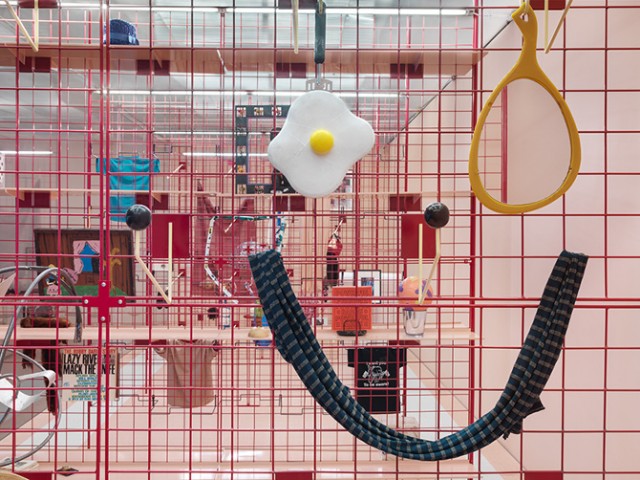
Eiko performs one of her solos for an intimate audience in a Lower East Side textile studio as part of Danspace Project’s “Platform” series (photo by twi-ny/mdr)
A BODY IN PLACES: EIKO SOLO #4
Danspace Project
St. Mark’s Church in-the-Bowery
131 East Tenth St. between Second & Third Aves.
Monday – Friday through March 19, $20, varying times
Platform continues through March 23
866-811-4111
www.danspaceproject.org
eiko solo #4 slideshow
New York-based Japanese dancer and choreographer Eiko Otake’s “A Body in Places” is the centerpiece of Danspace Project’s tenth “Platform” series, a five-week multidisciplinary exploration of Eiko’s work, including live performances, art and video installations, film screenings, lectures and discussions, a book club, and more. Every Monday through Friday, Eiko will be performing “A Body in Places: Eiko Solos,” unique hour-long dances that occur around Danspace’s home at St. Mark’s Church on East Tenth St. Between ten and twenty-five ticket holders will meet at the church, then be led to a secret location, where Eiko will perform exclusively for them. On March 3, the group walked over to 44 East Third St., a three-story townhouse that once was the home of the Reuben Gallery, the site of the first Happenings back in 1959, and currently the studio of textile artist Suzanne Tick. The performance began in the basement, as Eiko, wearing a luxurious kimono, moved alongside Tick working at a loom as the audience gathered around the space. At her trademark slow pace — but with occasional bursts of energy — Eiko headed up the stairs and continued in the main room, spreading out her arms and legs, then bringing her body together in an almost fetal-like position, and even emitting guttural sounds, before heading to the top floor, where, during part of her performance, one of Tick’s cats rested next to her on the floor until Eiko got up and eventually concluded with a flourish in the outdoor patio. It was an intimate, one-of-a-kind performance, a modern-day Happening, during which the performer and the crowd bonded in touching ways amid the unusual surroundings. The solos continue through March 19 at a different time each day; among the other locations on the schedule are the ANNA clothing store on East Eleventh St., Middle Collegiate Church on Second Ave., Dashwood Books on Bond St., the Sirovich Center for Balanced Living on East Twelfth St., and the Zürcher Gallery on Bleecker St. For our interview with Eiko about the Platform series as a whole, go here.

 Cemetery of Splendor is another strange, magical tale from Thai director Apichatpong Weerasethakul, a film that exists on the edge of sleep and wakefulness, like a dream you’ve just had but can’t quite remember all the details of, yet you know it has soothed your soul. In the jungles of Khon Kaen (Weerasethakul’s hometown) in Thailand, an elementary school has been turned into a makeshift hospital treating soldiers who have a mysterious sleeping ailment. (The story was inspired by an actual quarantine of members of the Royal Thai Army in 2012.) Built on the site of a long-ago palace and its cemetery of kings, the clinic uses light therapy to help the sleeping patients, each of whom has a curved fixture by their bed that emits neon lights that continually change color. Jen (Jenjira Pongpas, who also plays a woman named Jen in Weerasethakul’s Mekong Hotel), who attended the school as a child and walks with a pair of crutches because her legs are two different lengths, visits her old friend Nurse Tet (Petcharat Chaiburi), who runs the clinic with Dr. Prasan (Boonyarak Bodlakorn). “The soldiers just sleep,” Nurse Tet says. “The army doesn’t know what to do with them.” Jen develops a bond with one of the patients, Itt (Banlop Lomnoi), eventually communicating through a psychic medium, Keng (Jarinpattra Rueangram), who works with the police contacting the spirits of murder victims and helping find missing persons. At times, Itt wakes up, his sense of smell sharpened, able to “tell the temperature of the lights,” only to fall asleep again. Karma, meditation, past lives, and religious statues and spirits entering human bodies become part of the unusual narrative, all while a parcel of land is curiously being dug up with construction equipment nearby.
Cemetery of Splendor is another strange, magical tale from Thai director Apichatpong Weerasethakul, a film that exists on the edge of sleep and wakefulness, like a dream you’ve just had but can’t quite remember all the details of, yet you know it has soothed your soul. In the jungles of Khon Kaen (Weerasethakul’s hometown) in Thailand, an elementary school has been turned into a makeshift hospital treating soldiers who have a mysterious sleeping ailment. (The story was inspired by an actual quarantine of members of the Royal Thai Army in 2012.) Built on the site of a long-ago palace and its cemetery of kings, the clinic uses light therapy to help the sleeping patients, each of whom has a curved fixture by their bed that emits neon lights that continually change color. Jen (Jenjira Pongpas, who also plays a woman named Jen in Weerasethakul’s Mekong Hotel), who attended the school as a child and walks with a pair of crutches because her legs are two different lengths, visits her old friend Nurse Tet (Petcharat Chaiburi), who runs the clinic with Dr. Prasan (Boonyarak Bodlakorn). “The soldiers just sleep,” Nurse Tet says. “The army doesn’t know what to do with them.” Jen develops a bond with one of the patients, Itt (Banlop Lomnoi), eventually communicating through a psychic medium, Keng (Jarinpattra Rueangram), who works with the police contacting the spirits of murder victims and helping find missing persons. At times, Itt wakes up, his sense of smell sharpened, able to “tell the temperature of the lights,” only to fall asleep again. Karma, meditation, past lives, and religious statues and spirits entering human bodies become part of the unusual narrative, all while a parcel of land is curiously being dug up with construction equipment nearby.
 At the end of the closing credits of Thai director Apichatpong Weerasethakul’s Mekong Hotel, a disclaimer reads, “All characters appearing in this work are actual persons. Any resemblance to other real beings, living or dead, is not coincidental.” As with so many of the Palme d’Or-winning director’s films, Mekong Hotel walks the fine line between fact and fiction, fantasy and reality. The slight work, a meditative tone poem that runs fifty-seven minutes, was shot at the Sam Oar Guesthouse and Resort in Nong Khai in northeast Thailand, near the Friendship Bridge that links Thailand and Laos. Weerasethakul (Blissfully Yours, Syndromes and a Century) plays himself in the film, a director auditioning a guitarist (real-life musician and composer Chai Bhatana), whose playing serves as the musical score for the elegiac tale. (Assistant director Chatchai Suban also makes a cameo.) Meanwhile, an otherworldly narrative is taking place, between Tong (Sakda Kaewbuadee), a banana plantation owner whose dog was just eaten, and Phon (Maiyatan Techaparn), a young woman who lives next door with her mother, Jen (Jenjira Pongpas), a Pob ghost who has a hankering for entrails. (The relationship between the mother and daughter was inspired by one of Weerasethakul’s unrealized projects, Ecstasy Garden.) The slow, contemplative mood never changes as the characters discuss love, a coming flood, refugees, spirits, and jet skiing, often in abstract ways. Weerasethakul wrote, directed, produced, edited, and photographed the film, which features beautiful cinematography, the camera never moving as the characters walk in and out of the frame and the lovely views of the Mekong River linger. Unfortunately, the sum of the intriguing parts don’t make for a cohesive whole; Weerasethakul has been justly celebrated for his short films and full-length works, but Mekong Hotel falls somewhere in between, lost in a kind of no-man’s land. Still, there’s much to admire about this film, especially for the auteur’s longtime fans. Mekong Hotel is having its theatrical premiere at the IFC Center from March 4 to 10 in the series “Mysterious Splendors: The Films of Apichatpong Weerasethakul,” running alongside his latest film, Cemetery of Splendor.
At the end of the closing credits of Thai director Apichatpong Weerasethakul’s Mekong Hotel, a disclaimer reads, “All characters appearing in this work are actual persons. Any resemblance to other real beings, living or dead, is not coincidental.” As with so many of the Palme d’Or-winning director’s films, Mekong Hotel walks the fine line between fact and fiction, fantasy and reality. The slight work, a meditative tone poem that runs fifty-seven minutes, was shot at the Sam Oar Guesthouse and Resort in Nong Khai in northeast Thailand, near the Friendship Bridge that links Thailand and Laos. Weerasethakul (Blissfully Yours, Syndromes and a Century) plays himself in the film, a director auditioning a guitarist (real-life musician and composer Chai Bhatana), whose playing serves as the musical score for the elegiac tale. (Assistant director Chatchai Suban also makes a cameo.) Meanwhile, an otherworldly narrative is taking place, between Tong (Sakda Kaewbuadee), a banana plantation owner whose dog was just eaten, and Phon (Maiyatan Techaparn), a young woman who lives next door with her mother, Jen (Jenjira Pongpas), a Pob ghost who has a hankering for entrails. (The relationship between the mother and daughter was inspired by one of Weerasethakul’s unrealized projects, Ecstasy Garden.) The slow, contemplative mood never changes as the characters discuss love, a coming flood, refugees, spirits, and jet skiing, often in abstract ways. Weerasethakul wrote, directed, produced, edited, and photographed the film, which features beautiful cinematography, the camera never moving as the characters walk in and out of the frame and the lovely views of the Mekong River linger. Unfortunately, the sum of the intriguing parts don’t make for a cohesive whole; Weerasethakul has been justly celebrated for his short films and full-length works, but Mekong Hotel falls somewhere in between, lost in a kind of no-man’s land. Still, there’s much to admire about this film, especially for the auteur’s longtime fans. Mekong Hotel is having its theatrical premiere at the IFC Center from March 4 to 10 in the series “Mysterious Splendors: The Films of Apichatpong Weerasethakul,” running alongside his latest film, Cemetery of Splendor.



